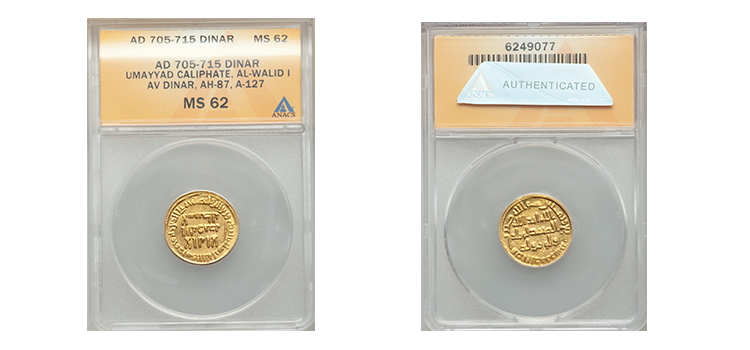Umayyad Caliphate Gold Dinar
The Umayyad dinar was the first coin to articulate the Islamic Faith. The first one was believed to have been struck in the year 77 of Hijra ( 696/7AD) in time for the pilgrimage season so that every Muslim could take home a statement of their faith as a coin in their pocket. It also stood as a contrast to the images that the Byzantine emperors were using on western coins.

Rise of Muslim Coinage
While the Eastern Roman (Byzantine) and Sasanian Persian empires battled endlessly over territory, a new religion — Islam — began to unite the Arab tribes to their south during the early Seventh Century. Following the death of the prophet Muhammad, the Muslims continued their conquests. The territory they acquired became known as the Caliphate, from the Arabic word Khalifa, which means both “successor” (to the leadership of Prophet Muhammad) and “deputy” (of Allah).
Abd al-Malik ibn Marwan became the fifth Caliph of the Umayyad dynasty in 685 A.D. following a bitter civil war. During his 20-year reign, he established Arabic as the official language of the Muslim world. He also sought to unite the territories through currency. The first Muslim coins were copies of Byzantine and Sassanid coins. Under Caliph Abd al-Malik, the coinage got its own identity.
Evolution of the Gold Dinar
The Caliphate dinar resembled the Byzantine solidus in both size and weight. However, Caliph Abd al-Malik ensured that the coin was distinctly Muslim. The first coins featured the Muslim profession of faith: “There is no god but God alone; Muhammad is the Messenger of God.”
Byzantine emperor Justinian II responded to be making his solidus more overtly Christian. He moved his own image to the reverse of the coin and placed an image of Jesus Christ on the obverse, marking the first time that Christ had been featured on a coin and an emperor was relegated to the reverse.
In response, Abd al-Malik placed an image of a standing human (likely the caliph) bearing a sword in a scabbard on the obverse of his coins. The inscription read: bism Allāh lā-ilaha il-Allāh wa / ḥdahu Muḥammad rasūl Allāh (“In the name of God. There is no god but God alone. Muḥammad is the messenger of God”). The dinar’s reverse featured a column placed on three steps and topped with a sphere. It also included the inscription: bism Allāh ḍuriba hadhā al-dīnār fī sanat sitta wa sabʿīn (“In the name of God, this dinar was struck in the year 76”).
The “standing-caliph” dinar was minted for just three years. Abd al-Malik’s redesign eliminated all images and only included quotations from the Qur’an. Each side featured a circular inscription around three lines of Arabic text.
The obverse reads: “There is no God but Allah alone, he has no associate.” It is surrounded by: “Muhammad is the messenger of Allah, he sent him with guidance and the true religion to make it victorious over every religion.” (Quran, 9:33)
The reverse reads: “Allah is one, Allah is eternal. He did not beget and he was not begotten.” It is surrounded by: “In the name of Allah, this dinar was struck in the year 77.”
After he introduced the new dinar, Abd al-Malik issued a decree making it the only accepted currency in the Caliphate. He also instructed that all remaining Byzantine and Arab-Byzantine coins be returned to the treasury, which would melt and restrike the coins. The failure to comply could result in the death penalty.
